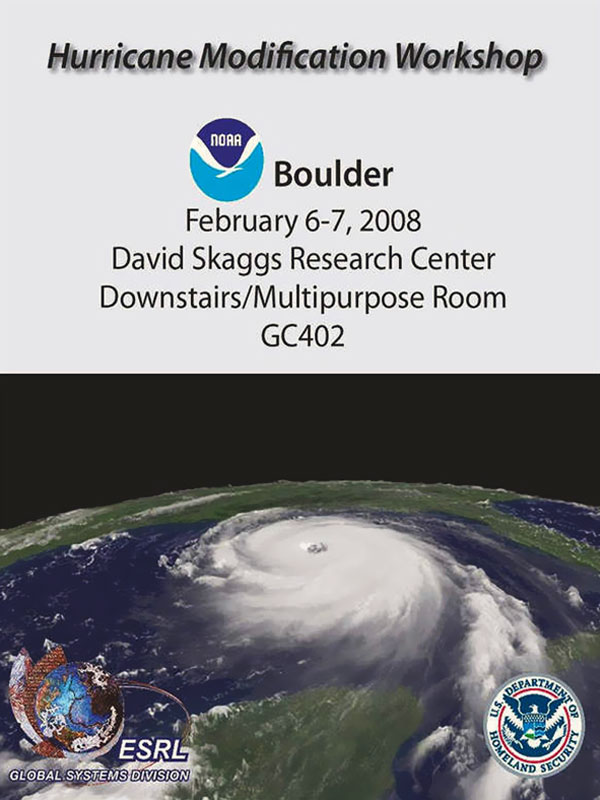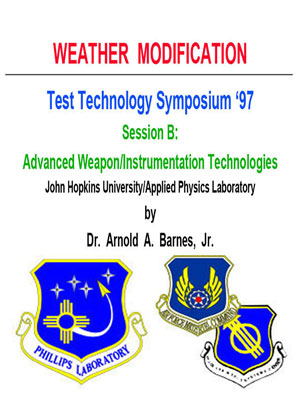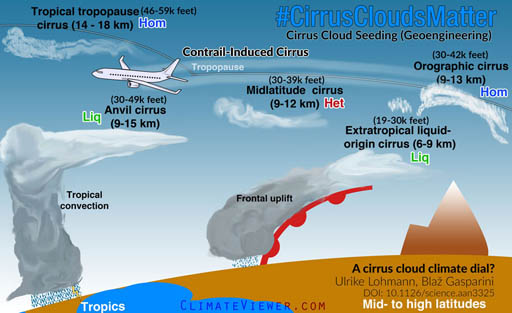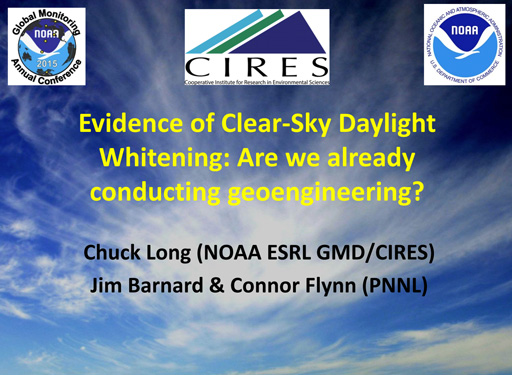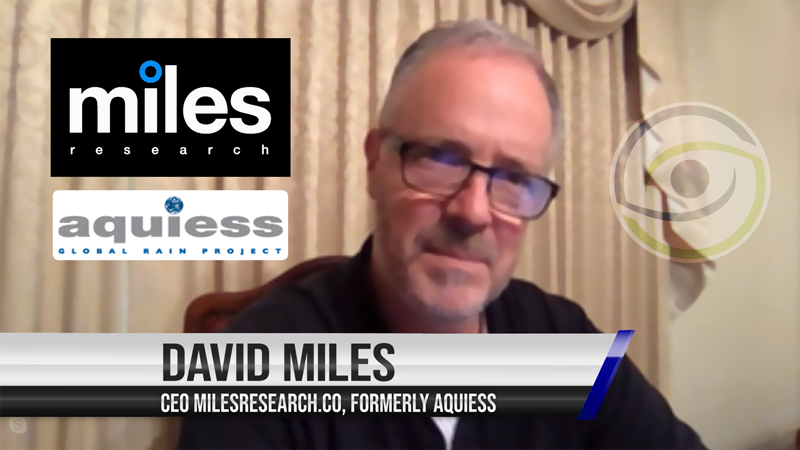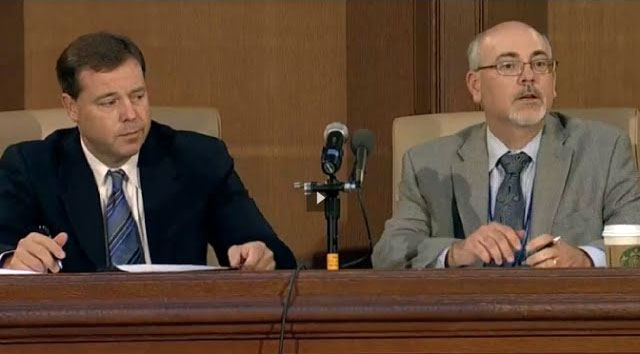
I’ve been heckling Ken Caldeira for years about how climate scientists lack credible computer models to predict global warming or the effects of Geoengineering Solar Radiation Management (SRM). When the EPA asked for public opinion on regulating six greenhouse gasses emitted by commercial jet aircraft, I went to a hearing in Washington D.C. and told the EPA panel that they better start focusing on clouds, scientifically referred to as contrail-induced cirrus. Finally, somebody’s listening!
CLOUD shows pre-industrial skies cloudier than we thought - CERN Website - YouTube Video
The cloud-climate conundrum
by Judith CurryFour new papers remind us of the very large uncertainties surrounding cloud-climate feedbacks.
CERN
CERN’s CLOUD Experiment recently published three new papers:
- Ion induced nucleation of pure biogenic particles
- The role of low-volatility organic compounds in initial particle growth in the atmosphere
- New particle formation in the free troposphere: A question of chemistry and timing.
Clouds need to condense around small particles called aerosols to form, and human aerosol pollution—primarily in the form of sulfuric acid—has made for cloudier skies. That’s why scientists have generally assumed Earth’s ancient skies were much sunnier than they are now. But today, three new studies show how naturally emitted gases from trees can also form the seed particles for clouds. The results not only point to a cloudier past, but they also indicate a potentially cooler future: If Earth’s climate is less sensitive to rising carbon dioxide (CO2) levels, as the study suggests, future temperatures may not rise as quickly as predicted.
“It’s been long thought that sulfuric acid is really the key player [in cloud formation],” says atmospheric chemist Chris Cappa of the University of California, Davis, who was not involved in the research. The studies “show pretty convincingly that we don’t need sulfuric acid around to allow new particles to grow.”
The new research, however, suggests that the past may have been cloudier than scientists realized. To simulate ancient atmospheric conditions, one research group used CLOUD (Cosmics Leaving OUtdoor Droplets), a controlled chamber at CERN, Europe’s particle physics facility near Geneva, Switzerland. Nearly as big as a bus, the chamber was filled with synthetically produced air, allowing precisely controlled chemical conditions. Jasper Kirkby, a CERN particle physicist, and his colleagues introduced a mixture of natural oxidants present in the air and an organic hydrocarbon released by coniferous plants. The hydrocarbon was rapidly oxidized. The only other ingredient allowed in the chamber was cosmic rays, high energy radiation from outer space, which made the molecules clump together into aerosols. Sulfuric acid was not required. In fact, even when the researchers introduced low concentrations of sulfuric acid to the chamber such as might be found in unpolluted air, the aerosol formation rate was unaffected. In a second CLOUD experiment published simultaneously in Nature, researchers showed these same oxidized molecules could rapidly grow the particles to sizes big enough to seed cloud droplets.
In search of a pristine atmospheric environment, a second group of researchers made atmospheric measurements of aerosol formation at the Jungfraujoch high altitude research station, 3500 meters up in the Swiss Alps to confirm that this process really occurs in nature. Over the course of a year, they measured the changing concentrations of sulfuric acid and organic molecules in the air. They found more aerosols formed with more organic molecules around, and—crucially—observed formation of organic particles without sulfuric acid. They used exactly the same instruments as at CLOUD to analyze the aerosols: “The clusters were formed mainly by organics,” says atmospheric chemist Federico Bianchi of the Paul Scherrer Institute in Villigen, Switzerland, who led the Jungfraujoch research published today in Science.
All the researchers stress sulfuric acid is still a major contributor to cloud formation on Earth today. “Today the purely plant-based pathway is much less important than it was preindustrially,” Kirkby explains. Crucially, however,the result means climate modelers can’t assume that the ancient past was much less cloudy simply because there was less sulfur dioxide. If ancient cloud cover was closer to today’s levels, the increase in the cloud-cooling effect due to human pollution could also be smaller—which means that Earth was not warming up so much in response to increased greenhouse gases alone. In other words, Earth is less sensitive to greenhouse gases than previously thought, and it may warm up less in response to future carbon emissions, says Urs Baltensperger of the Paul Scherrer Institute, who was an author on all three papers. He says that the current best estimates of future temperature rises are still feasible, but “the highest values become improbable.” The researchers are currently working toward more precise estimates of how the newly discovered process affects predictions of the Earth’s future climate.
Nature News also has an article on the papers: Cloud-seeding surprise could improve climate predictions. Excerpts:
The findings run contrary to an assumption that the pollutant sulphuric acid is required for a certain type of cloud formation — and suggest that climate predictions may have underestimated the role that clouds had in shaping the pre-industrial climate.
If the results of the experiments hold up, predictions of future climate change should take them into account, says Reto Knutti, a climate modeller at the Swiss Federal Institute of Technology. For 20 or more years, clouds have been the largest source of uncertainty in understanding how manmade emissions affect the atmosphere, he says.
In addition to releasing carbon dioxide, burning fossil fuels indirectly produces sulphuric acid, which is known to seed clouds. So, climate scientists have assumed that since pre-industrial times, there has been a large increase in cloud cover, which is thought to have an overall cooling effect by reflecting sunlight back into space. And they have assumed that this overall cooling effect has partially masked the climate’s underlying sensitivity to rising carbon dioxide levels.
The latest experiments suggest that it may have been cloudier in pre-industrial times than previously thought. If this is so, then the masking effect, and in turn the warming effects of carbon dioxide, might have been overestimated, says Jasper Kirkby, a physicist at the CERN, Europe’s particle-physics laboratory near Geneva, Switzerland, who led one of the experiments.
But Kirkby adds that it is too early to say whether this is true in practice, or by how much, because there are so many factors that play into such projections. “There are many uncertainties; we are only talking about one,” says Kirkby. Knutti says the results will probably not affect the most likely projections of warming, as laid out by the Intergovernmental Panel on Climate Change. “Our best estimate is probably still the same,” he says.
Until recently, atmospheric scientists thought that only sulphuric acid vapour, which can be produced by volcanic emissions or by burning fossil fuels, could trigger this process. As a result, it was thought that pre-industrial skies were somewhat less cloudy than present ones because they contained less of this pollutant, says Kirkby.
In addition to feeding into climate predictions, the findings have another potential implication, says atmospheric scientist Bjorn Stevens of the Max Planck Institute for Meteorology in Hamburg, Germany. Some scientists have warned that measures such as scrubbing sulphur dioxide from coal-plant emissions could remove some of the beneficial cooling effect of clouds and boost global warming, but this may now be less of a concern because trees can seed clouds too. “What it means is, we don’t have to fear clean air,” says Stevens.
It is also interesting to speculate whether trees emit these compounds in part because there is a benefit to them in making their own climate, Kirkby says. “This really does touch on the Gaia hypothesis,” he says, referring to the theory that Earth’s life behaves as a single organism that tends to preserve itself. “It’s a beautiful mechanism for trees to control their environment.”
Finish reading The cloud-climate conundrum and be sure to read the comments!






